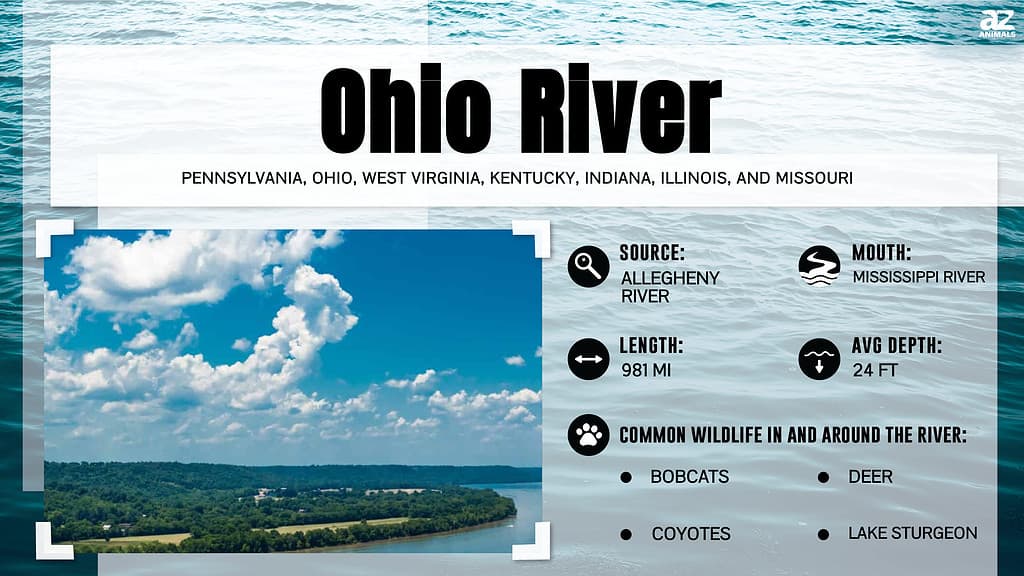
The Ohio River is 981 miles long and runs along six states including West Virginia, Pennsylvania, Ohio, Kentucky, Indiana, and Illinois.
The river supplies drinking water to over five million people and has an assortment of fish living within it. Some of these fish can get pretty big.
Let’s take a look at some of the biggest fish that can be found in the Ohio River.
Catfish
There are three different types of catfish that are most common in the Ohio River. They are Channel catfish, Flatheads, and Blue catfish. Blue catfish are more likely to be found in the lower river and are rarer in places like the West Virginia, Ohio, and Pennsylvania parts of the river.
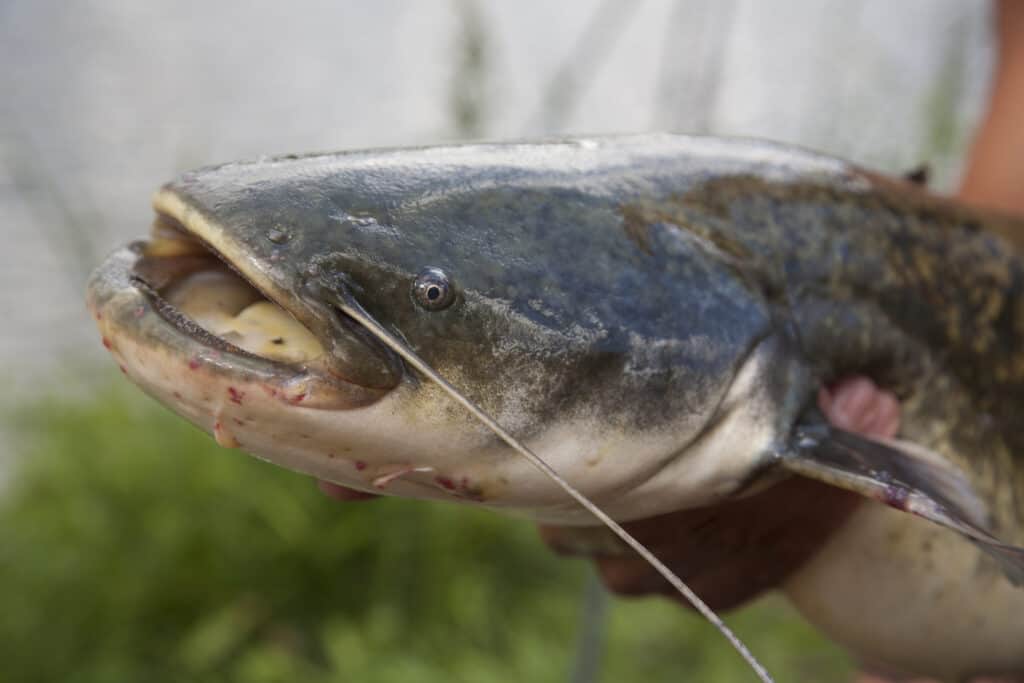
The Mississippi delta is where the majority of the US catfish are farmed and processed.
©Kutikan/Shutterstock.com
Channel Catfish
Channel catfish are pretty common along all parts of the Ohio River and normally weigh up to 15 pounds. They are easily distinguishable from most other types of catfish, except for the blue catfish, thanks to their tail fin, which is deeply forked. They differ from flathead catfish because their upper jaw projects outward farther than their lower jaw.
These catfish are typically olive-brown in color or slate-blue on their sides and their backs. On their bellies, they’re silvery-white. You may also notice that the fish has very small black spots, which can be numerous, but these markings may be harder to see on the larger adults.
Channel catfish will typically spawn during the late spring or early summer—whenever the temperature of the water reaches 75 degrees. The males of this species will select a nest site, which will usually be any area that is very dark and secluded. This could be places like logs, drift piles, or rocks. The male will then guard the nest and will even eat some of the eggs if they’re disturbed. The remaining eggs will hatch within roughly a week.
There are some Channel catfish that have reached an excess of 36 pounds in weight. The current North American record for the largest Channel catfish is a whopping 58 pounds!
Blue Catfish
Blue catfish is a common type of catfish that can be found in many different states, whether they are coastal or inland. These fish are native to Ohio, Missouri, Mississippi, and the Rio Grande. Blue catfish have been introduced in many areas, and are sought out by many anglers because they present a good challenge for fishing.
These fish have unexpectedly spread out to areas where they were not originally intended to be and are now considered to be an invasive species, so recreational fishing for them has been encouraged in many places.
Blue catfish are distinguished by their flat dorsal fin and deeply forked tail. They’re a silvery-blue color with white bellies. They do not have scales so their skin is smooth. They also have four whisker-like barbels around their mouths. Adult Blue catfish can grow to be around 2 feet long but are known to be as large as 5 feet. Some of them can even reach up to 100 pounds.
In some cases, Blue catfish can even exceed 100 pounds. There was a case where one was caught on the Virginia-North Carolina border. It weighed a massive 143 pounds!
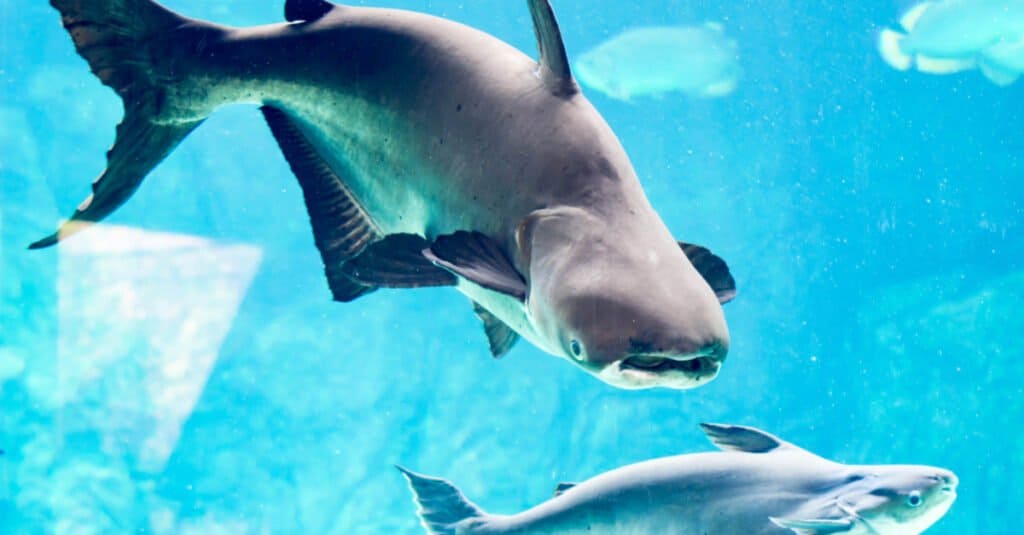
The largest blue catfish on record weighed 143 pounds!
©Bill Roque/Shutterstock.com
Flathead Catfish
This type of catfish can be identified by its broadly flattened head and a lower jaw that projects out further than its top jaw (the reverse of the Channel Catfish). The tail of this catfish is slightly notched and its adipose fin is large.
As far as coloring goes, this catfish is yellowish (or cream-colored) and has dark brown, olive-brown, or black mottling on its back and sides, which fades into a pale/dirty yellow or white. On the younger fish, you’ll be able to see their markings more clearly, as they are darker in color. On the upper tip of the fish’s tail, you’ll find white triangular patches.
The Flathead catfish are known to be more solitary than the other types of catfish. They are omnivorous and will feed during the nighttime. Their diet consists of almost a wide variety of creatures such as crustaceans, mollusks, other fish, and even insect larvae or terrestrial creatures that find their way into the river. The Flathead catfish feed on other living fish, more than any other type of catfish will. You can find them feeding near the surface of the water, as they will often occupy the more shallow waters, unlike other catfish.
Like Blue catfish, you can sometimes see Flathead catfish reach weights upwards of 100 pounds! The more common Flathead catches see them weighing between 20-30 pounds on average.
Longnose Gar
Gar is a type of prehistoric fish that have unique, interesting features. There are three different species of gar that can be found along the Ohio River. They are the Spotted gar, the Shortnose gar, and the Longnose gar. We will only discuss the Longnose gar because the other two species of gar are currently on the endangered species list.
This means that if you happen to catch either of the two types of gar that are endangered, they should be released immediately. You can refer to identification guides that have illustrations so that you can see the differences between the different types of gar to know which one you have caught.
Longnose gars are able to survive during the summer in waters that would normally be too warm and lack dissolved oxygen for most other fish species. This is thanks to their ability to swallow water and obtain oxygen from it. They have a prehistoric look to them because of their hard, bony scales which provide them with protection from predators.
This roughly textured skin also shields them from the dense forms of vegetation that you may find them in. Since these fish have a rough fish status in Ohio, fishermen are allowed to use bow fishing, snagging, and spearing according to the regulations allowed.
Longnose gar can be commonly seen during the summer. The Ohio state record for the largest Longnose gar caught was 49 inches long and weighed 25 pounds. This Longnose gar was caught in 1966 in the Ohio River.
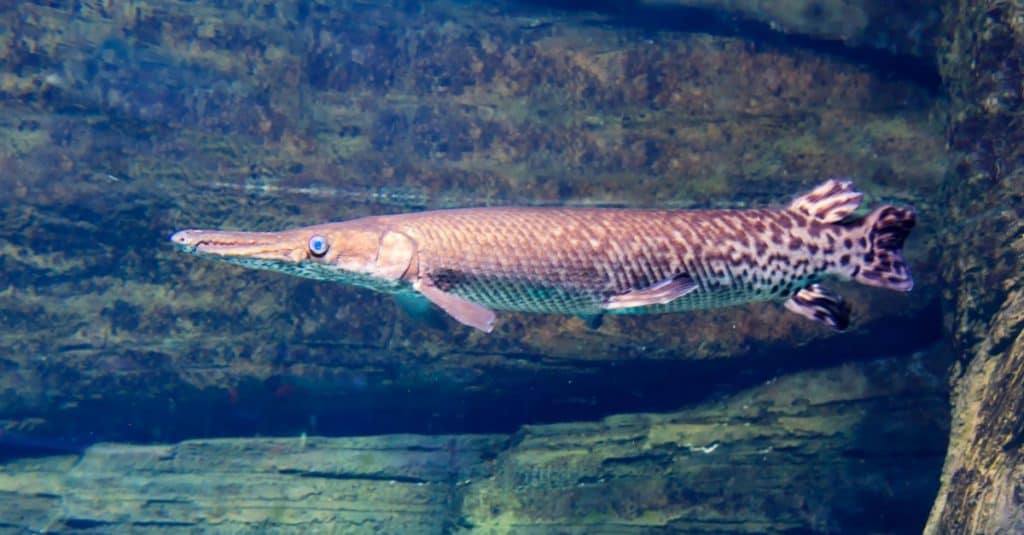
Anglers use a variety of methods to catch longnose gar, including bow fishing, snagging, and spearing where regulations permit.
©Galina Savina/Shutterstock.com
Striped Bass
Striped bass is a large fish with an oil green to blue-grey coloring with silver-white sides. These fish are distinct from other types of bass because of the horizontal lines or stripes that run along their sides. These stripes are more intense and noticeable than those on other basses like the White bass. The stripes on the Striped bass are often unbroken and extend the entire length of the fish’s body.
The average size of a Striped bass is between 2-3 feet in length and 10-30 pounds in weight. Some Striped basses have been known to reach 6 feet long and weigh up to 125 pounds! This species of bass lives in coastal saltwater but migrates up to freshwater rivers in order to spawn. However, it is very possible for populations to survive and grow in numbers within impounded rivers. The Striped bass population in Kentucky, for example, is maintained through the use of stocking. This only occurs in Lake Cumberland and the Ohio River.
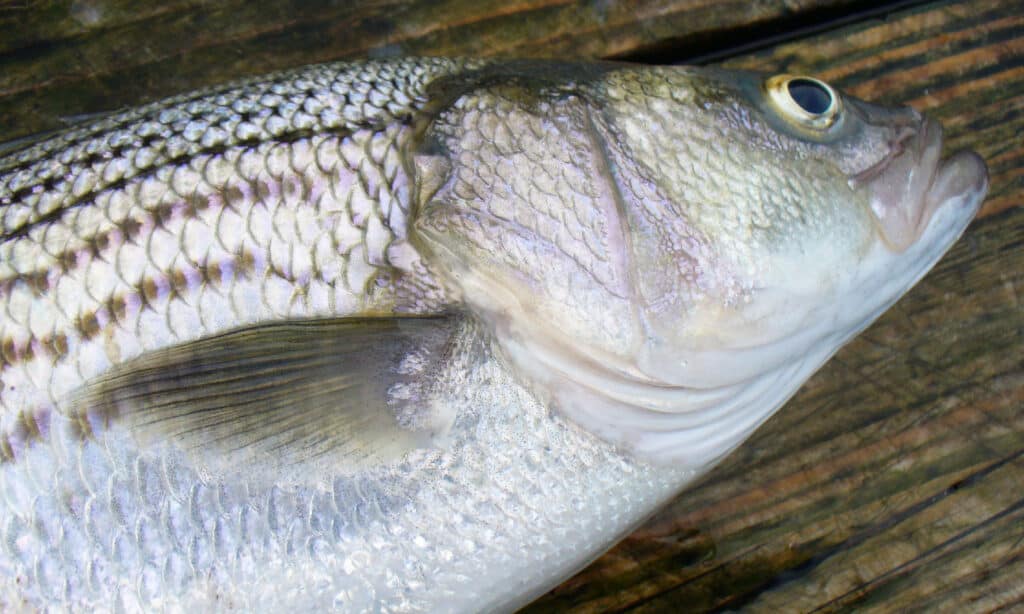
Striped bass can reach up to 6 feet long and weigh up to 125 pounds. Talk about a monster fish!
©iStock.com/Coast-to-Coast
Catfish Fishing
Catfish are the most common catch when fishing the Ohio River and can be easily caught by shore anglers. They can be caught almost any time water temperatures are above 50 degrees, but night fishing during May, June, and July is best. Tailwaters yield the most fish, but warm water discharges, stream confluences, and gravel flats near deep water are proven producers of big cats. The largest catfish caught on the Ohio River weighed 106.9 pounds, caught by Glynn Grogan in 2018.
How Big Can a River Fish Get?

The size of river fish can vary greatly depending on the species.
©Arunee Rodloy/Shutterstock.com
The size of river fish can vary greatly depending on the species. Some species of river fish, such as small minnows, may only grow to a few inches in length, while other species, like catfish, can grow to be several feet long.
The world record for the largest river fish ever caught is currently held by a Mekong giant catfish, which weighed in at over 650 pounds and was nearly 9 feet long. Other large river fish species include sturgeon, paddlefish, arapaima, and alligator gar, which can grow to several hundred pounds in weight and over 7 feet in length.
It is important to note that many of these larger river fish species are highly prized by anglers and are often subject to overfishing and habitat loss, which can have a negative impact on their populations.
Where Is the Ohio River Located on a Map?
The Ohio River begins in Pittsburgh, Pennsylvania, and ends in Cairo, Illinois. It empties into the Mississippi River.
Summary of the Largest Fish in the Ohio River
| Species | Maximum Size Caught |
|---|---|
| Channel Catfish | 58 pounds |
| Blue Catfish | 143 pounds |
| Flathead Catfish | Over 100 pounds |
| Longnose Gar | 25 pounds |
| Striped Bass | 125 pounds |
The photo featured at the top of this post is © slowmotiongli/Shutterstock.com
Sources
- Ohio Department of Natural Resources, Available here: https://ohiodnr.gov/buy-and-apply/hunting-fishing-boating/fishing-resources/fishing-ohio-river
- NOAA Fisheries, Available here: https://www.fisheries.noaa.gov/species/blue-catfish
- Kentucky Department of Fish & Wildlife Resources, Available here: https://fw.ky.gov/Fish/Pages/Striped-Bass.aspx
FAQs (Frequently Asked Questions)
What fish are found in the Ohio River?
In the Ohio River, you can find bluegill, largemouth bass, catfish, and many others.
What is the biggest fish in the Ohio River?
One of the biggest fish you can catch in the Ohio River is the Catfish.
Is the Ohio River a good place to catch fish?
The Ohio River makes a good place to catch fish. There are a wide variety of fish to catch and some that will give fishermen a challenge.
Thank you for reading! Have some feedback for us? Contact the AZ Animals editorial team.







